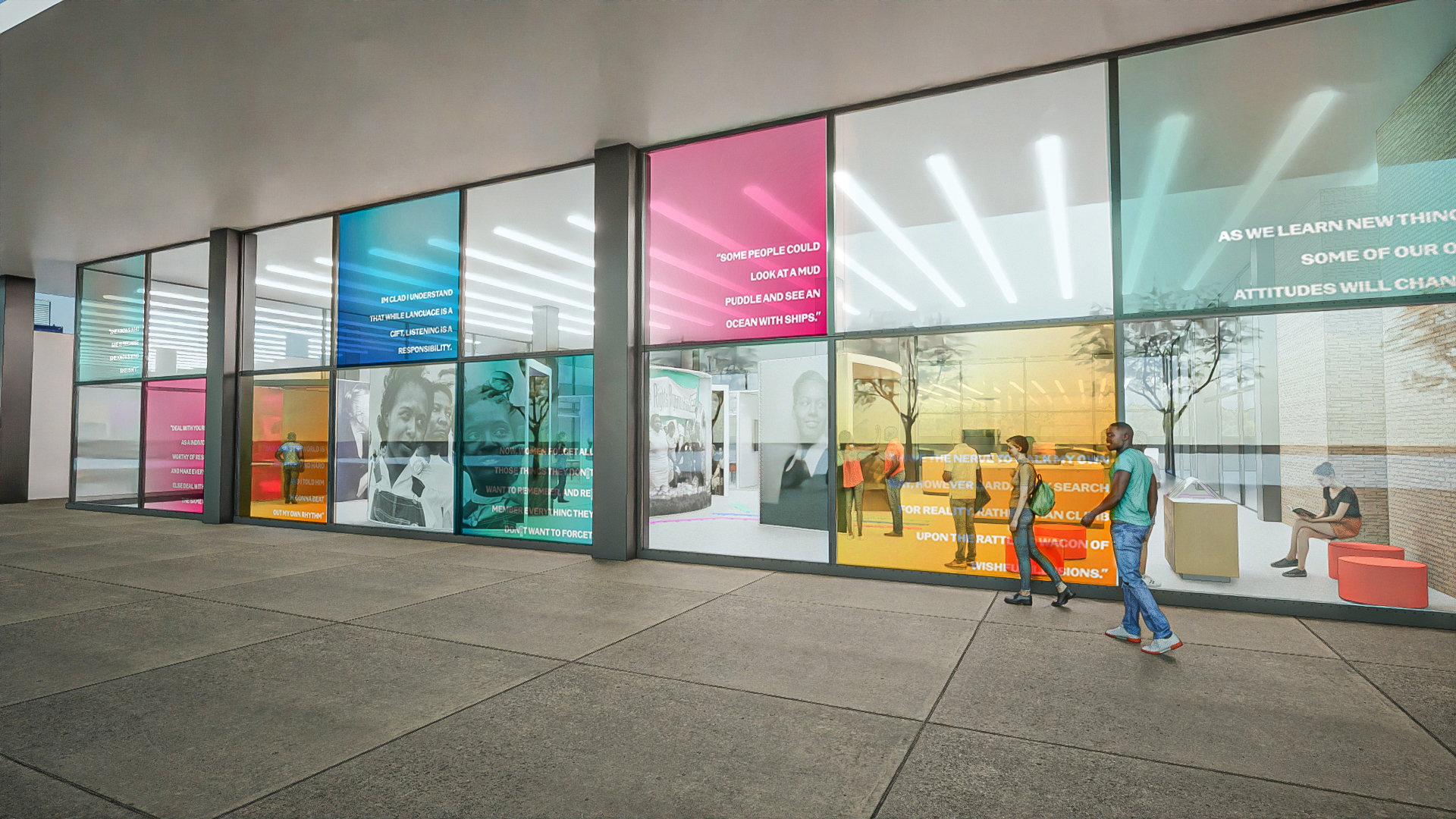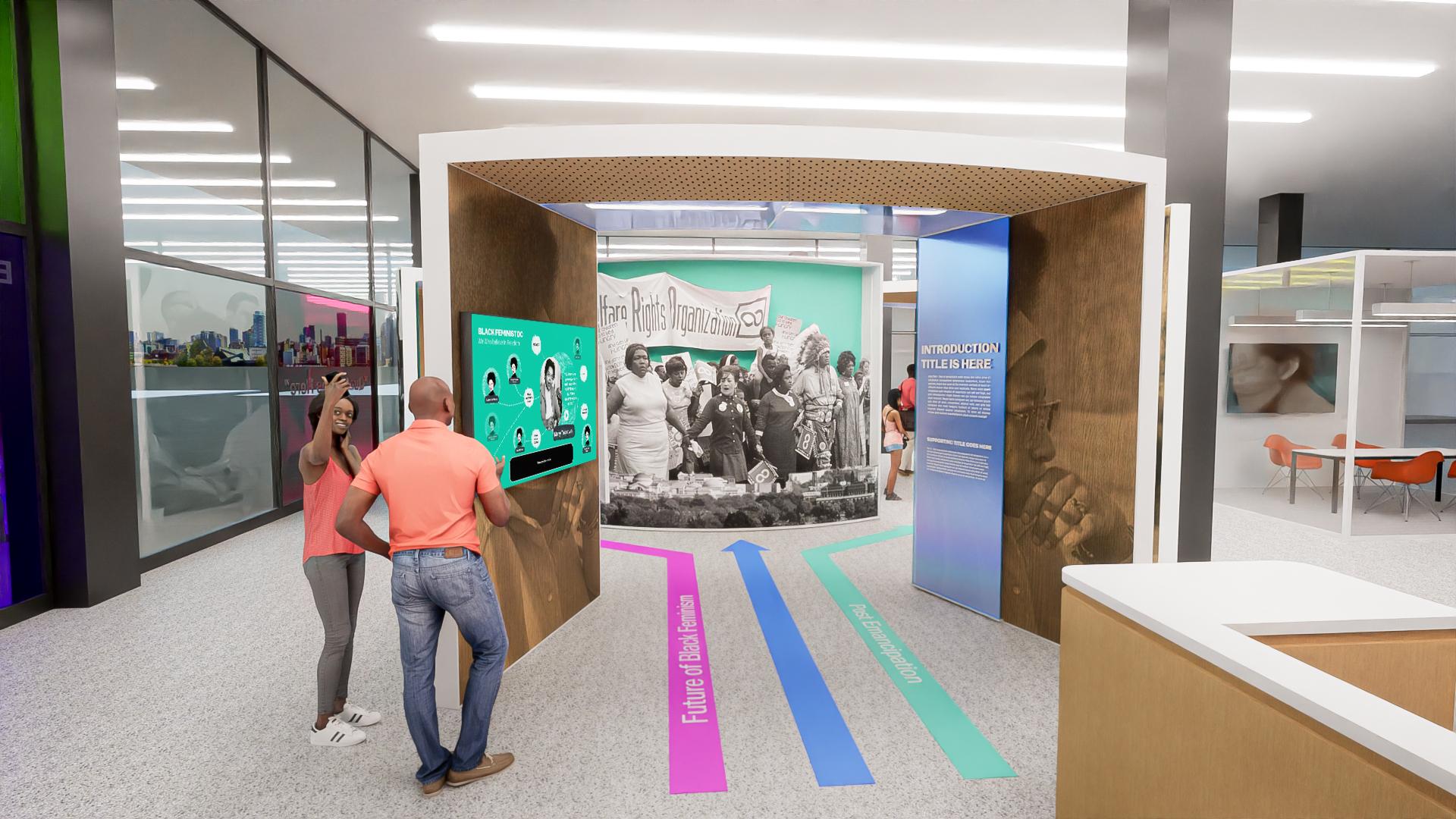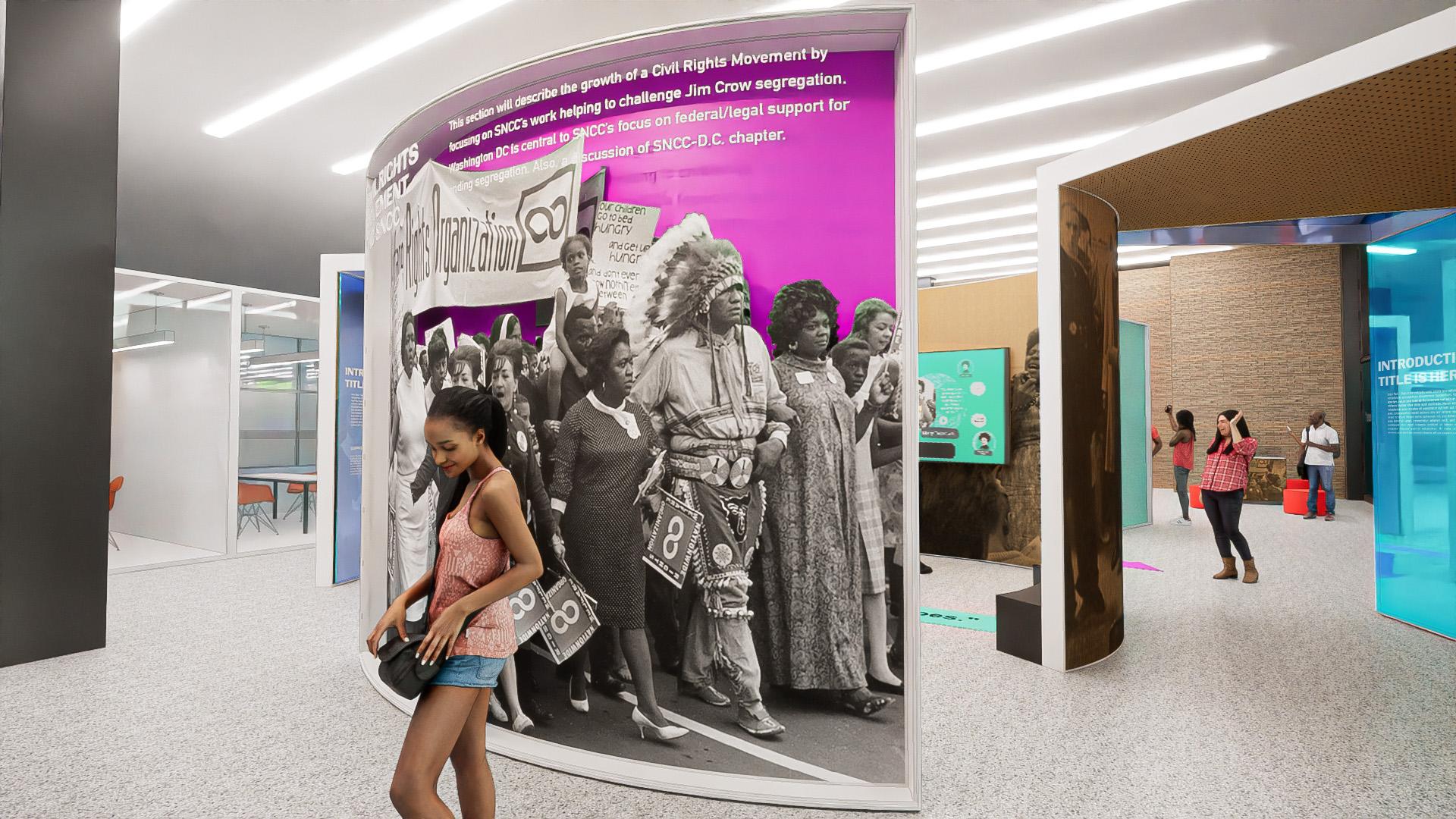Behind the Scenes of "We Who Believe in Freedom"

The Museum’s inaugural exhibit at the Martin Luther King Jr. Memorial Library in downtown Washington, DC, highlights the voices of Black feminist organizers and theorists who fought for a definition of freedom and liberation that extended beyond their individual circumstances. The exhibit examines these voices and stories, from the early Black feminism of the “Jane Crow” era to the future of Black feminism. Equally as important as the content of the exhibition is the way in which the content is presented, so when assembling the team to help put together the inaugural exhibit, it was important to find a woman-owned exhibition-design firm that was willing and excited to take on this unique project. NWHM is excited to be working with Tessellate Studios, the design and production firm for the exhibit.
A woman-owned business, Tessellate Studios knew it wanted to work with the Museum on this project as soon as it saw the call for proposals. The team at Tessellate recognized that its design studio and the Museum shared values about the importance of teaching the historical context in order to shed light on the contemporary issue.
Tessellate was excited not only by the organizations’ shared values, but by the content of NWHM’s first physical exhibit. Each member of the team “was drawn to nuanced aspects of the Black feminist DC narrative” which the curatorial team sought to explore. The designers appreciated the ways in which the Museum’s exhibition incorporates representations of Black women who shaped the United States and the ways that it will amplify “Black women’s impact as change makers.” Tessellate explained that honoring those stories through innovative and carefully chosen design was its “collective interest,” and that the team felt inspired by the ingenuity and resourcefulness of the Black women activists who organized in Washington, DC. The team notes, “These stories are part of our collective history as women, and there is a lot of knowledge and inspiration that can and should be carried forward...We wanted to bring a fresh, engaging, and elevated way of telling these stories to more people.”

In reflecting on the experience of designing the Museum’s inaugural exhibition, Tessellate shared that “there were definitely challenges in designing for this space, but it’s been fun to think of ways to turn those into opportunities.” It is the process of tackling those challenges, as well as an enjoyment of creative problem-solving, that binds the team of physical, visual, interactive designers, and creative technologists at Tessellate Studios together.
The studio’s name reflects its approach to showcasing the exhibition’s content: “A tessellate is a type of pattern created by individual shapes that fit together to create a larger whole—one with endless limitations.” Tessellate believes that “exhibit design is one aspect of experience design,” and aims to creates storytelling environments that center on and encourage engagement. As the design team “takes a holistic approach to storytelling,” Tessellate focuses on the big idea and the way in which everything, from the font on panels to the materials of structures to the modes of interactivity, contributes to the message an exhibition conveys. A focus on collaboration ensures that Tessellate’s designs complement and “bring to life” an exhibition’s content.
The Martin Luther King Jr. Memorial Library poses unique challenges and possibilities for exhibition design—challenges the Tessellate team was excited to tackle. The team considers the MLK Library not only eye-catching, but also, as a historic building, a unique exhibition space. In order to honor and work with the historic nature of the MLK Library, Tessellate adopted a “‘do no harm’ design ethos.” Tessellate wants NWHM’s exhibit to work with the unique space of the MLK Library rather than fighting against or altering the space.
The team also wants its design to embrace what the Martin Luther King Jr. Memorial Library is at its core: a library and community space that brings in an audience who may not typically visit or feel welcome in a traditional museum. For the Tessellate team, it is important to draw in both the casual visitors who come to the library to check out a book, study, or grab lunch from the cafe downstairs and those who specifically come to the corner of G Street Northwest and 9th Street Northwest to see the exhibition.
In order to capture the casual and interested viewer alike, as well as passers-by, the exhibition designers are working with “the size and scale of the MLK Library.” The team is both excited and daunted by how the two walls of floor-to-ceiling windows, the rigid details of the building, and the terrazzo flooring will play into its design. In particular, Tessellate understands that the “abundance of natural and ambient light” is “an inherent quality” it wants to use in the exhibition’s design. Tessellate cares about taking advantage of this brilliant light, looking to create opportunities for color, shadow, and transparency in the graphic panels that make up the exhibit, and what the team at Tessellate Studios has come up with is vibrant and engaging. Tessellate’s design uses color not only as a palette but also as a medium for telling the stories of Black feminist organizers in Washington, DC.
Centering the content, voices, and experiences of Black feminists is of the upmost importance to the Tessellate team throughout the entire design process. In addition to considering the best panels to showcase the amazing images of the women in the exhibit, the team thinks about how its design choices and partners can reflect the values of the exhibit. Tessellate reflected that its “graphic designer, Lauren Sloan, chose a title font that is from a Black-owned type foundry called Vocal Type Co.” to highlight how it has been “keeping that idea of ‘voice’ in our minds as we design.”
Sloan chose a title font called “Marsha,” named for Marsha P. Johnson, the African-American, transgender activist who was an important advocate for homeless LGBTQ+ youth, those effected by HIV and AIDS, and gay and transgender rights during the mid- and late-20th century. The designers also strive to create an environment that supports the curators’ decision to invite “the women whose stories we are telling to be the narrators of their own stories.” For example, the 10 featured women in the exhibition will be given voice via audio clips so that “people can hear their own words, in their real voices.” To complement this content, Tessellate has designed panels that display ephemera—such as a book, a manifesto, or an LP album—that a featured woman wrote or made. Tessellate feels that by “showing what each woman was inspired to create, it allow[s] their voices to be heard” by visitors.
Tessellate knows that flexibility is at the heart of any exhibition design process. The group starts each project by asking a lot of questions of and listening to stakeholders, looking to evoke a lot of thinking and discussion from everyone. Even if the team of stakeholders is not able to articulate exactly what it wants from the beginning, Tessellate knows that “somewhere between the lines are clues and ideas and a creative direction.” For NWHM’s inaugural exhibit, Tessellate understands that the Museum “[is] interpreting a topical story that continues today,” so it has created a contemporary design.

One of the ways in which the Tessellate team intends to highlight the contemporary element of this story is by focusing on the historical images used throughout the exhibition. Rather than presenting these historical images as those of the past stuck in black and white, the designers want to change viewers’ impressions. They focus on color and layers to create a rich design that synthesizes the “idea of layered stories.” Color reflects the vibrancy of these women’s lives. Layers of materials “physically show how these women’s lives and work overlap and build upon each other.” Tessellate shared that hitting upon this design idea was “like an ‘aha’ moment that everyone caught on to immediately.” The NWHM staff and curators had a similar reaction, realizing that Tessellate had landed on a meaningful way to showcase the exhibit’s compelling and inspiring content.
While the Museum has articulated its own reasons and goals for producing this exhibition on Black feminist DC, the question remains about what the design team hopes for audiences when they experience this exhibit. One of its main goals, Tesselate shared, “is to offer opportunities for learning and engagement, which the Museum shares as well.”
Tessellate’s designers want their design choices, such as the bright colors and layering of graphic treatments, to help “bring the women featured in the exhibit into a contemporary context” while simultaneously bringing “new energy into the mostly black and white images.”
The design team believes that this exhibition tells not just a historical narrative, but a contemporary one, as well. It is a narrative that audiences need to know in order to understand both our past and our present. Tessellate maintains “the problems these activists were fighting for—civil rights, fair labor, reproductive justice, LGBTQ+ rights, housing equality, a seat at the table—still exist today for Black women.” It has planned its design around the belief that addressing the present is just as important as informing audiences about the past.
Tessellate hopes that after seeing this exhibit, visitors will recognize that “women are still fighting for freedom and equal rights, and Black feminists have been doing this for generations—fighting for everyone to be free.” With Tessellate’s attention to detail and respectful and holistic approach to the content, the Museum’s inaugural exhibition will make a profound and lasting impact.
The Tessellate Team
Emily Conrad is the co-founder, president, and principal experience designer at Tessellate Studios. Her work is based on the belief that designing an experience is different from delivering information, and that the more senses are engaged, the more memorable the experience will be. With 17 years of experience as a design leader and skilled manager, Emily oversees multiple design disciplines, including the creative direction for Tessellate’s interaction, software, media, and custom technology design. Emily earned an MPS in Interactive Telecommunications from New York University (ITP/NYU) and a BA in Studio Art and Earth Sciences from Earlham College.
Joseph Karadin is the co-founder, executive creative director, and exhibit design lead at Tessellate Studios. A highly experienced architect and exhibit designer, Joe has more than 20 years of experience in immersive environmental design. His passion is exploring new ways of creating, communicating, and producing physical and digital design to shape experiences. His design practice focuses on the complex interconnections between content, experiences narratives, and spatial arrangements spanning across many different project types. He has won several awards and distinctions for his work. Joseph teaches as an Adjunct Instructor of Exhibit Design at FIT in New York City and graduated from Cornell University with a Bachelor of Architecture.
Lauren Sloan is a visual designer at Tessellate Studios. Throughout Lauren’s career as a designer, she has witnessed how the power of teamwork and collaboration uplifts each project. Designing for the built environment intrigues Lauren because it is diverse in nature and challenges her to think multi-dimensionally. Lauren has over a decade of experience working as a graphic designer for exhibits and the built environment. Lauren has designed and managed over 50 temporary exhibits in Manhattan and over four national exhibits for Christie’s, New York. Lauren holds a BA in Graphic Design from Anderson University.
Photos: © 2022 Tessellate Studio.
